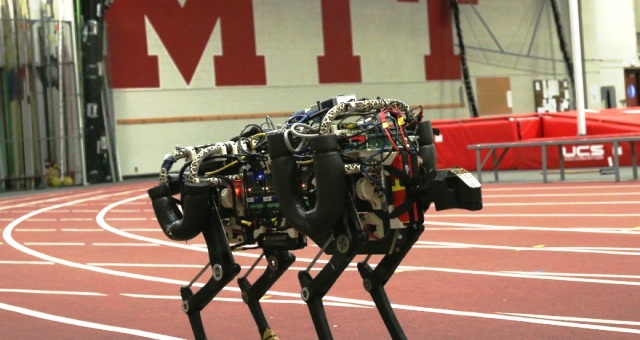
A single machine with quadruple mechanical limbs is achieving excellent advances in the area of robotics. Experts have invented a robot that has been inspired by a wild cat. The robot can run at a remarkable pace and hop over obstacles in its path.
The ‘automated cheetah’ initially showed off its skills last autumn, where scientists at the Massachusetts Institute of Technology (MIT) revealed its top speed of 16-kilometers—roughly 10 miles—per hour. However, at this point, the robot has returned to an exciting and new technique. It now possesses the ability to hop over obstacles. The robot is one of the earliest robots to be able to spot challenges from a point in the distance, and leap over them with virtually no help from its creators. The MIT team came seventh in 2015’s DARPA Robotic Challenge. The first position was taken by Team KAIST from Daejeon, South Korea.
#DARPA funded #robot #cheeta has shown immense advances with #MIT engineers working on it. #robotarmyhttps://t.co/eq708MmLRx
— Anon.Dos (@anondos_) February 25, 2016
The machine is able to recognize obstacles in its path by making use of an optical setup referred to as light recognition and varying. The unit, which is positioned on the panel of the cheetah robot, directs a compact laser beam that reflects back from the things in its path. This LIDAR setup allows the automation to create a digital guide of its territory, which is then transferred to a built-in processing unit developed with a number of course organizing formulas.
The algorithmic rules assist the automation in observing its surroundings, and allows it to figure out what strategy to use. For instance, it is able to work out the dimensions of the blocks across its course, and can determine how distant they truly are. The robot can even figure out the simplest way to get past a hurdle; for example, the robot will figure out how high it should hop in order to safely travel over a wall.
“A moving hop is an undoubtedly one of the vibrant actions; You’ve got to take care of stability and power and have the ability to deal with the effect after touching down. Our robot is created specifically for such extremely dynamic conducts,” says Kim Sang-Bae, an associate lecturer in mechanical engineering at Massachusetts Institute of Technology.
Presently, the cheetah robot can remove difficulties while performing at the rate of eight-kilometers per hour, and it is able to leap over materials more than forty-six centimeters high, which happens to be over fifty percent of the height of its own body. Until now, the cheetah robot’s jumping capabilities have already been examined simultaneously on a treadmill machine and in an in-house track. Within the track, the automaton cleared about seventy percent of the difficulties positioned throughout its course. However, the intelligent robot did much better in the roofed course, where it possessed more room and, consequently, a lot more duration to identify challenges and discover ways to recover from them. During the course of the test runs on the indoor track, the robot cleared ninety percent of the challenges, according to scientists.
In the years ahead, the scientists are interested in bringing the robot to a live environment. Although they have already started to take the robot out on the campus and test its capabilities there, the scientists plan on running the robot across the United States. But let’s see how many more surprises MIT has installed for us.
Source: The Daily Dot
You want to support Anonymous Independent & Investigative News? Please, follow us on Twitter: Follow @AnonymousNewsHQ
This Article (MIT Develops A Cheetah Robot That May Become Deadly In The Future) is free and open source. You have permission to republish this article under a Creative Commons license with attribution to the author and AnonHQ.com.




